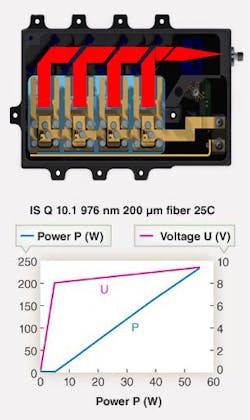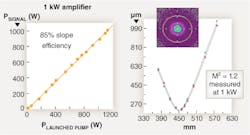BRYCE SAMSON, JENS BIESENBACH, AND GEORG TREUSCH
Recent developments in high-power fiber-laser technology are closely related to improvements in high-brightness fiber-coupled pump laser diodes. Today it is possible to build kilowatt-level fiber lasers operating at 1 µm, based on standard commercial fiber, components, and 976 nm laser diodes. Advances in eye-safe fiber-laser technology indicate that the same path is likely at 2 µm based on thulium-doped fibers and 790 nm diode technology.
High-power diode pump modules
A common interface between a diode pump module and the fiber laser is the 100 to 200 µm fiber pigtail typically with a numerical aperture (NA) of 0.12 to 0.22. These diode pigtails are often spliced to fiber combiners to further increase the available pump power (see Fig. 1).
For the longest time, 100 µm fiber was used in the domain of single emitters only. The power level from a fiber-coupled single emitter has steadily increased to more than 10 W at wavelengths above 900 nm, and less than 10 W for the range of 790 to 810 nm. Although the coupling efficiency of a single emitter to a 100/105 µm fiber now reaches values above 90%, this method falls short of the maximum brightness and fiber-coupled power because the single emitter underfills the fiber by a theoretical factor of 10 to 20 in its vertical direction.
High-power fiber lasers at the kilowatt power level are gaining momentum and require higher-brightness pump modules as the target laser power increases, requiring a switch to multi-emitter diode bars. These new high-brightness bars with increased cavity length, in combination with brightness-matching micro-optics, allow multiple emitters from a single bar to be coupled into a 100 µm fiber. Latest results using this approach demonstrate 50 W from a robust, industrial-proved design with a theoretical limit of more than 100 W. Because of the multi-emitter approach, this design enables high-brightness modules in the 790 nm wavelength range (for example, 20 W from a 5 mm bar and 40 W from a 10 mm bar). The free-space optics inside the module can be complemented by wavelength locking and protection from back-reflected fiber-laser light.
Fiber lasers using a master-oscillator power-amplifier (MOPA) architecture aiming for an output power in the kilowatt range require pump modules with more power (more than 200 W). Because the fiber diameter used in this configuration can go up to 200 µm, the high-brightness multi-emitter module previously described can be used as a building block to increase the power. By optical stacking and polarization coupling, multiple units (6 to 10) can be combined into a single 200 µm 0.2 NA fiber. The heat generated by the diodes is spread out on a common platform, allowing cooling with industrial water or high-performance thermoelectric coolers, and does not require deionized water used in micro channel cooled stacked arrays. A 976 nm fiber-laser device with four diode-laser bars can deliver more than 200 W from a 200 µm core fiber (see Fig. 2).The demand for even more power at reduced cost and increased brightness requires an optimized approach starting at the diode-laser bar and including a reduction in complexity of the micro-optics. A new design from DILAS that demonstrated 500 W from a 200 µm fiber-coupled module in 2007 confirms that a fill factor (emitter size divided by emitter pitch) in the range of 10% enables two important features: output power per emitter is similar to a single emitter due to eliminated thermal cross talk and optimized beam collimation in the slow axis (horizontal) direction is due to the 1:10 ratio of emitter size and pitch.
All emitters of a single bar can be coupled into a 200 µm fiber using a simple combination of slow-axis lens arrays and a single fast-axis collimation (FAC) lens. With a perfect FAC lens and low smile bars (deviation of less than 0.1 µm from a straight line), the theoretical limit in optical stacking of multiple bars is 30 to 40 bars for a 200 µm fiber. A number of 20 diode bars seems more realistic for the power increase and will aim at an output of more than 1200 W. At power levels exceeding a couple of hundred watts, the coupling efficiency into the fiber as well as the heat dissipation in the fiber connector are of utmost importance.
High-power fiber lasers at 1 µm
A kilowatt-class high-power MOPA system using commercially available fiber, pump combiners, and pump laser diodes can deliver 225 W of output power.1 This power level is achieved by combining six pump modules in a tapered fiber bundle for a total of 1.2 kW of pump power, which in turn pumps a single ytterbium (Yb)-doped double-clad fiber with 400 µm diameter and 0.46 NA (see Fig. 3). The high slope efficiency from this fiber amplifier building block readily enables more than 1 kW of power with single-mode beam quality. The advantage of this MOPA architecture is the flexibility and compatibility with various input seed sources. For example, Nufern has developed polarization-maintaining (PM) versions of these amplifiers that deliver significantly narrower linewidth than alternative designs.The current generation of kilowatt amplifiers has been tested with 8 GHz linewidth and it is likely that kilowatt-level fiber amplifiers will be capable of delivering single-frequency linewidth as stimulated-Brillouin-scattering mitigation techniques are developed for high power levels. Although not important for most industrial materials processing, control of linewidth and polarization are critical for many military applications—including beam combining. In addition, we typically find these high-power amplifier stages are more efficient than their oscillator counterparts at the same power level, which can be an advantage in cost of diodes as well as overall wall-plug efficiency. Based on the diode data in the previous section, the current high-brightness 976 nm diodes have an approximate 45% electrical-to-optical (E-O) efficiency making the total amplifier E-O efficiency around 35%. Further improvements are anticipated as the diode material improves.
Eye-safe fiber lasers
Most of the recent high-power fiber laser developments have utilized Yb-doped fibers pumped at 9xx nm and lasing around 1080 nm. However, high-power, high-efficiency fiber lasers operating at eye-safe wavelengths (longer than approximately 1.4 µm) are also of interest for military, industrial, and medical applications. The recent improvement in thulium (Tm)-doped fiber lasers operating around 2 µm has led to output powers from a single fiber laser now approaching 1 kW.2
A critical part of this development has been the optimization of 790 nm laser diodes for pumping Tm-doped fiber, specifically achieving the required high power and high brightness with good E-O efficiency (see Fig. 4).This pump technology, coupled with the latest advances in highly efficient Tm-doped fibers, has allowed eye-safe fiber laser technology to approach 25% wall-plug efficiency and further improvements are likely as diode material continues to mature at these new operating wavelengths.
REFERENCES
1. J. Edgecumbe et al., Proc. Directed Energy Professional Society SSDLTR, 193 (June 2008).
2. P. Moulton et al., Lasers and Applications in Science and Engineering (LASE 2008), paper 6873-15 (2008).
BRYCE SAMSON is vice president of business development at Nufern, 7 Airport Park Rd., East Granby, CT 06026; e-mail: [email protected]; www.nufern.com. JENS BIESENBACH is chief technology officer at DILAS Diodenlaser, Galileo Galilei-Strasse 10, D-55129 Mainz-Hechtsheim, Germany, and GEORG TREUSCH is vice president, Dilas Diode Lasers, 9070 South Rita Road, Suite 1500, Tucson, AZ 85747; www.dilas.com.



